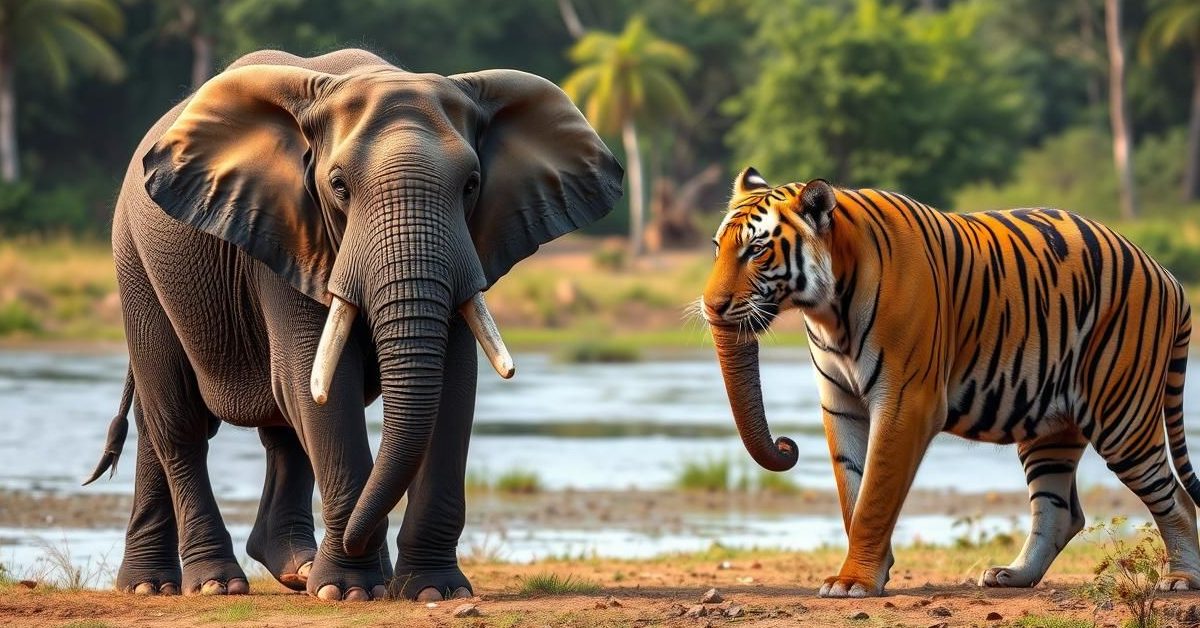Understanding India’s Magnificent Wildlife: Elephants and Tigers
India, a land teeming with biodiversity, is home to some of the world’s most iconic species. Among them, the majestic Asian elephant and the elusive Bengal tiger hold a special place in the nation’s heritage and conservation efforts. Understanding their habitats, challenges, and the initiatives designed to protect them is crucial for anyone keen on India’s rich natural tapestry.
Safeguarding India’s Gentle Giants: The Elephant Story
The elephant, India’s national heritage animal, embodies strength and grace. Efforts to protect these magnificent creatures are spearheaded by initiatives like **Project Elephant**, a centrally sponsored scheme of the **Union Environment Ministry**. This vital project oversees everything from habitat protection to resolving human-elephant conflicts, with its steering committee playing a pivotal role in conservation strategies. Recently, **Environment Minister Bhupender Yadav** chaired the 21st meeting, reviewing key progress, including the completion of Phase-I of the synchronized elephant population estimation for the Northeastern states.
These remarkable animals are afforded the highest level of protection under **Schedule I of the Indian Wildlife Protection Act, 1972**, highlighting their critically important status. Despite these efforts, recent census data, while still being finalized for the latest **’Status of Elephants in India 2022-23’** report, indicates a concerning decline in their numbers over the past five years.
Indian elephants boast a surprisingly diverse geographical spread. In the **northeast**, their range stretches along the **Himalayan foothills**, moving from **Nepal’s eastern border** through **northern West Bengal** and into **western Assam**. In **northwestern India**, fragmented populations dot the **Himalayan foothills of Uttarakhand and Uttar Pradesh**, from **Katranighat Wildlife Sanctuary** to the **Yamuna River**.
Southern India hosts eight distinct elephant clusters, including areas like **Northern Karnataka**, **Crystalline of Karnataka—Western Ghats**, **Bhadra—Malnad**, and the significant **Brahmagiri—Nilgiris—Eastern Ghats**. While the **Nilambur—Silent Valley—Coimbatore** region is a prominent elephant habitat, it’s a common misconception that it holds zero elephants; it’s, in fact, a crucial part of their southern range. Central India’s elephant populations, though fragmented, see individuals occasionally straying into **Chhattisgarh** from states like **Odisha** and **Jharkhand**, alongside the southern parts of **West Bengal**.
Addressing Human-Tiger Conflict: A New Strategy
The increasing proximity between human settlements and wildlife has unfortunately led to a rise in human-tiger conflicts across various forest divisions in India. To mitigate this escalating challenge, the **Union Environment Ministry** has initiated a proactive solution: a pilot scheme focused on managing **’tigers outside of tiger reserves’**.
This innovative plan, approved in principle for a one-year pilot by the executive committee of the **National Compensatory Afforestation Fund Management and Planning Authority (CAMPA)**, aims to enhance monitoring and protection strategies. It will channel funds to 80 identified forest divisions across ten states, chosen based on data from recurring human-tiger interactions.
The scheme’s implementation on the ground will be a collaborative effort, spearheaded by **state forest department Chief Wildlife Wardens** working closely with the **National Tiger Conservation Authority (NTCA)**. The allocated funds will facilitate crucial technical interventions, strengthening forest managers’ ability to handle conflicts through advanced technology, fostering collaboration with civil society organizations and veterinary professionals, and expanding the prey base to naturally reduce tigers’ need to venture into human-populated areas.
The Geopolitics of Power: Rare Earth Magnets
Beyond the realm of wildlife, critical environmental and geographical factors shape global industries, particularly the burgeoning electric vehicle (EV) market. **Rare earth magnets** are fundamental components in the motors of electric vehicles, playing an indispensable role in the shift towards sustainable transportation. Their importance extends to other high-tech applications, including clean energy technologies and various home appliances, even parts of traditional gasoline or diesel-powered vehicles like power windows and audio speakers.
The global supply chain for these magnets, however, presents a significant geopolitical challenge. **China** currently dominates this sector, controlling over 90% of the worldwide processing capacity for rare earth magnets. This immense influence was underscored recently when Beijing imposed export restrictions, mandating companies to obtain import permits, leading to diplomatic engagements, including India’s communication with China regarding supply issues. India’s automotive sector, for instance, sourced 460 tonnes of these crucial magnets primarily from China in the last fiscal year and anticipates importing 700 tonnes, valued at approximately $30 million, this year alone.
Mapping India’s Wilderness: Tiger Reserves and Sanctuaries
Identifying India’s rich network of protected areas is essential for understanding its conservation landscape. Let’s clarify the locations of some key tiger reserves and wildlife sanctuaries:
* **Palamau Tiger Reserve:** Located in **Jharkhand**, this is one of India’s original nine tiger reserves and the only one in the state.
* **Sariska Tiger Reserve:** Situated in the **Alwar district of Rajasthan**, Sariska is a renowned tiger habitat.
* **Madhav Tiger Reserve:** Found in **Madhya Pradesh**, specifically in the **Shivpuri District**, this reserve is part of the northern fringe of the Central Highlands. It was designated a National Park in 1958.
* **Hoollongapar Gibbon Sanctuary:** This protected area of evergreen forest is located in the **Jorhat district of Assam**, known for its unique gibbon population, and not in Sikkim.
* **Koyna Wildlife Sanctuary:** This sanctuary is correctly located in **Maharashtra**.
* **Kuno National Park:** Famous for its cheetah reintroduction project, Kuno is located in **Madhya Pradesh**.
* **Chinnar Wildlife Sanctuary:** This sanctuary is indeed located in **Kerala**.
The Thorny Issue of Water: Banakacherla Reservoir Project
Water, a precious resource, often becomes a flashpoint for interstate disputes. The **Banakacherla reservoir project** recently made headlines due to an ongoing water dispute between **Andhra Pradesh** and **Telangana**. This contention highlights the deep-seated issues over water allocation between the two states, intensified by public challenges from **Telangana Chief Minister A Revanth Reddy** to former Chief Minister and **Bharat Rashtra Samithi (BRS) leader K Chandrashekar Rao**.
The Banakacherla project’s core purpose is to transform the drought-prone **Rayalaseema area of Andhra Pradesh** into arable land. A key component of its first phase involves significantly increasing the capacity of the **Polavaram Right Main Canal** to facilitate the transfer of water from the **Godavari River** to the **Krishna River**, a vital step for regional water security.
Unveiling “Dark Oxygen” in the Clarion-Clipperton Zone
Beyond terrestrial and freshwater concerns, the vastness of our oceans holds profound mysteries. Scientists, long fascinated by the enigmatic “dark matter” in space, are now exploring “dark oxygen” deep within our planet’s oceans. A groundbreaking study published in **Nature Geoscience** revealed this unseen phenomenon within the **Clarion-Clipperton Zone (CCZ)**.
The **Clarion-Clipperton Zone** is a vast abyssal plain found in the **Pacific Ocean**, spanning a remarkable 6 million square kilometers. Here, at an astonishing depth of 4,000 meters (roughly half the height of **Mount Everest**), oxygen is being released from mineral deposits. This discovery challenges conventional understanding of ocean chemistry and highlights the unexplored complexities of our planet’s deep-sea environments.
The Epic Journey of Amur Falcons: ‘Kahuaipuina’
One of nature’s most spectacular migrations involves the **Amur Falcons (Falco amurensis)**. These captivating migratory birds, affectionately known as **’Kahuaipuina’** by local communities, arrive in large numbers in **northeastern India** every October, specifically gracing the skies of **Manipur** and **Nagaland**.
Their arrival marks a crucial stopover on their southbound migration. Originating from their breeding grounds in **northern China, eastern Mongolia**, and the **far eastern regions of Russia**, these falcons rest and refuel for three to four weeks. During this period, they voraciously forage on termites, building up vital fat reserves that power the next leg of their incredible journey to their wintering grounds in **South Africa**. Their presence is a testament to the interconnectedness of global ecosystems and the importance of preserving stopover sites along their migratory paths.















